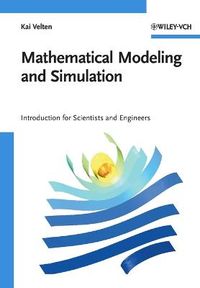
endast ny
Mathematical Modeling and Simulation: Introduction for Scientists and Engin Upplaga 1
This concise and clear introduction to the topic requires only basic knowledge of calculus and linear algebra - all other concepts and ideas are developed in the course of the book. Lucidly written so as to appeal to undergraduates and practitioners alike, it enables readers to set up simple mathematical models on their own and to interpret their results and those of others critically. To achieve this, many examples have been chosen from various fields, such as biology, ecology, economics, medicine, agricultural, chemical, electrical, mechanical and process engineering, which are subsequently discussed in detail.
Based on the author`s modeling and simulation experience in science and engineering and as a consultant, the book answers such basic questions as: What is a mathematical model? What types of models do exist? Which model is appropriate for a particular problem? What are simulation, parameter estimation, and validation?
The book relies exclusively upon open-source software which is available to everybody free of charge. The entire book software - including 3D CFD and structural mechanics simulation software - can be used based on a free CAELinux-Live-DVD that is available in the Internet (works on most machines and operating systems).
Upplaga: 1a upplagan
Utgiven: 2009
ISBN: 9783527407583
Förlag: John Wiley & Sons
Format: Häftad
Språk: Engelska
Sidor: 362 st
This concise and clear introduction to the topic requires only basic knowledge of calculus and linear algebra - all other concepts and ideas are developed in the course of the book. Lucidly written so as to appeal to undergraduates and practitioners alike, it enables readers to set up simple mathematical models on their own and to interpret their results and those of others critically. To achieve this, many examples have been chosen from various fields, such as biology, ecology, economics, medicine, agricultural, chemical, electrical, mechanical and process engineering, which are subsequently discussed in detail.
Based on the author`s modeling and simulation experience in science and engineering and as a consultant, the book answers such basic questions as: What is a mathematical model? What types of models do exist? Which model is appropriate for a particular problem? What are simulation, parameter estimation, and validation?
The book relies exclusively upon open-source software which is available to everybody free of charge. The entire book software - including 3D CFD and structural mechanics simulation software - can be used based on a free CAELinux-Live-DVD that is available in the Internet (works on most machines and operating systems).
Ny bok
1404 kr1477 kr
5% studentrabatt med Studentapan
Begagnad bok (0 st)
Varje vecka tillkommer tusentals nya säljare. Bevaka boken så får du meddelande när den finns tillgänglig igen.



